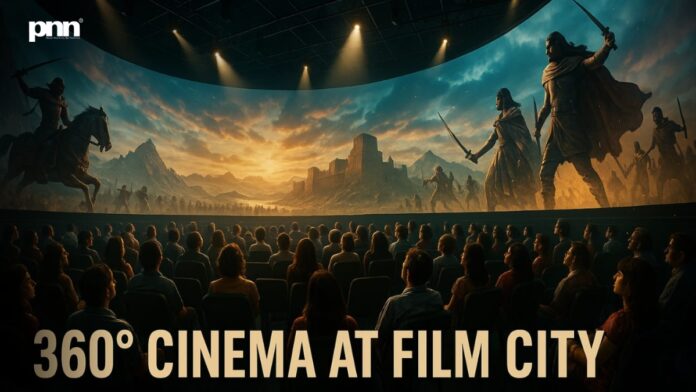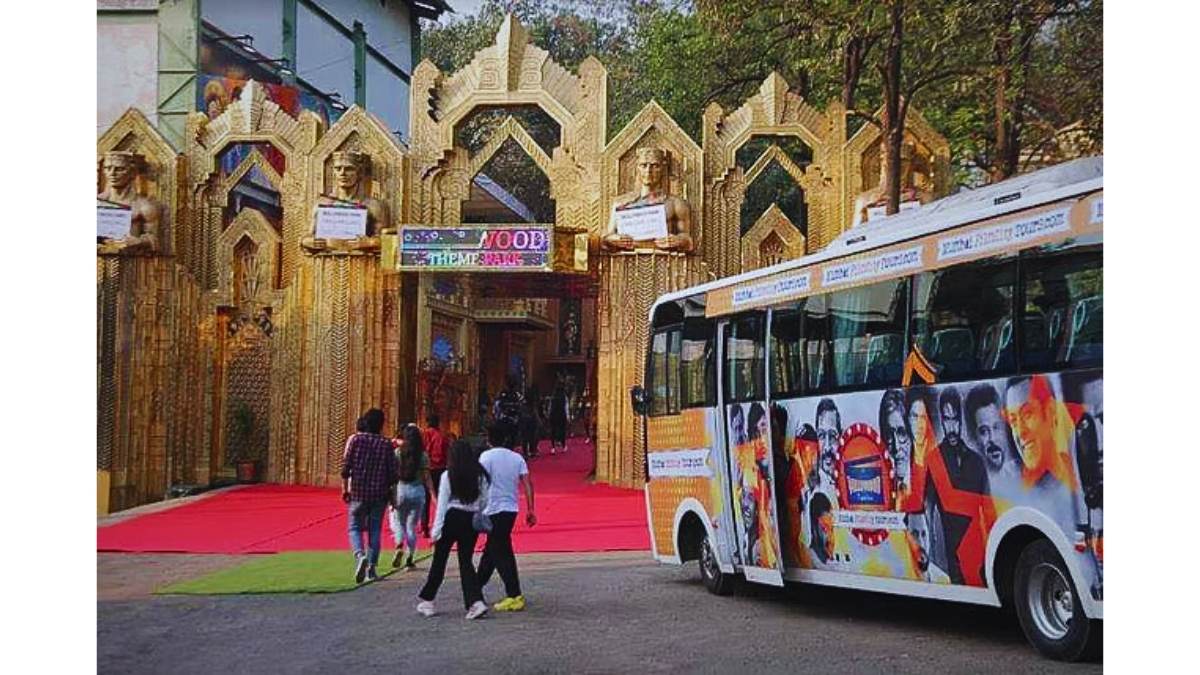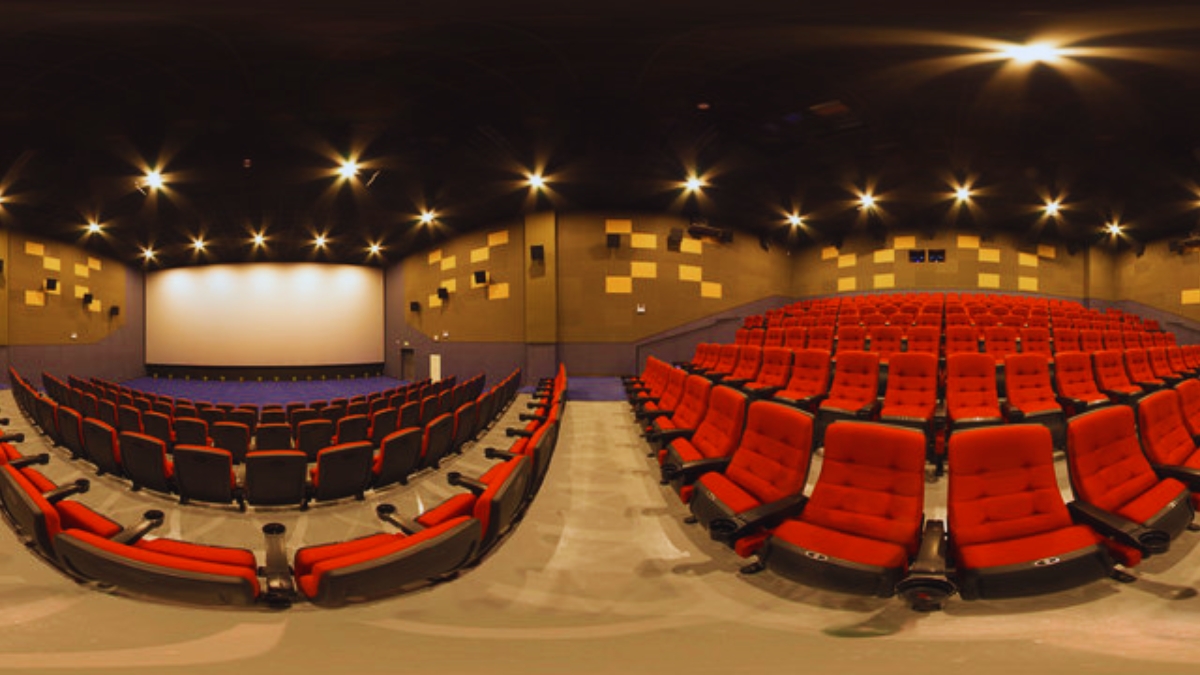Mumbai (Maharashtra) [India], October 4: If Bollywood ever needed a reminder that cinema isn’t just about stories, but about the way we experience them, the newly launched 360-Degree Cinema at Film City, Mumbai has delivered it—wrapped neatly in LED brilliance and marketing gloss. The much-talked-about installation promises “knowledge, thrill, and experience” — a trifecta that sounds suspiciously like a movie trailer itself.
Launched amid camera flashes, dignitaries, and a healthy dose of cinematic self-importance, this immersive theatre marks another ambitious attempt to turn Indian cinema into a full-fledged sensory playground. It’s the kind of venture that makes you wonder — if movies already made us cry, laugh, and scream, what happens when they literally surround us?
The Experience: Cinema Beyond the Screen
Imagine standing in the center of a dome-shaped theatre, surrounded by massive 360-degree visuals that blur the line between film and fantasy. You’re not watching a movie anymore — you’re inside it.
That’s the essence of this new venture by the Maharashtra Film, Stage & Cultural Development Corporation (MFSCDC), in collaboration with leading tech innovators. From panoramic documentaries on India’s heritage to hyper-realistic short films showcasing cinematic artistry, the project aims to educate, entertain, and slightly overwhelm.
The first phase, insiders say, involved an investment crossing ₹30 crore — a modest figure by Bollywood standards but a major leap for educational entertainment. “We’re not just making films. We’re building experiences,” said a senior Film City official during the launch. And yes, the irony of saying that in a city that literally builds experiences every day wasn’t lost on anyone.
When Bollywood Meets Tech Tourism
The 360° Cinema isn’t just a theatre. It’s part of a broader push to rebrand Film City as an experiential tourism hub, complete with guided tours, AR-enhanced exhibits, and perhaps — in classic Mumbai fashion — overpriced popcorn.
The cinema itself is equipped with 12K projection technology, dynamic surround sound, and an immersive seating design that moves subtly with the visuals. It’s been compared to Tokyo’s digital art museums and the VR dome theatres of Dubai — except, this one comes with a uniquely Indian twist: a narrative-driven soul that still believes in “intervals”.
Industry insiders hint that the theatre could soon host short films, VR documentaries, and even AI-enhanced cinema modules for film students. “This isn’t just a tourist gimmick,” said one filmmaker, “it’s a playground for visual innovation.” That said, there are already whispers about whether the venture will sustain momentum beyond the initial novelty rush.
Lights, Camera… Infrastructure?
For all its promise, the launch of 360° Cinema also reignited familiar questions — the kind that Bollywood’s glossy exterior often hides. Can Mumbai’s infrastructure handle such futuristic experiences while Film City itself struggles with maintenance and access issues?
As one visitor dryly noted, “It’s amazing how the future of cinema has arrived, but the parking lot is still from 1995.”
Yet, even critics agree that such ventures mark a turning point. India has long flirted with immersive cinema — from 4D theatres in malls to occasional VR exhibitions — but this is the first large-scale government-backed setup designed to merge education and entertainment.
Reinventing the Film City Narrative
Film City has often been described as a relic of Bollywood’s golden age — a sprawling complex of studios, nostalgia, and controlled chaos. But with 360° Cinema, there’s a deliberate attempt to rebrand it as a 21st-century innovation hub.
This structural shift is no coincidence. Maharashtra’s cultural ministry has been quietly planning a “Film City 2.0” overhaul — one that brings in sustainable architecture, digital training facilities, and tourism-led revenue. The immersive theatre, therefore, is just Act One of a much bigger production.
Sources suggest that a second dome — designed for international co-productions and short immersive series — is already on the drawing board, with a projected completion timeline of 2026.
The PR Glitter & the Real Picture
As expected, the launch drew Bollywood personalities, bureaucrats, and a healthy stream of influencers trying to get the perfect “360° selfie”. The film fraternity largely hailed it as “a landmark innovation”, though a few cynical voices online have dubbed it “an expensive school field trip with sound effects.”
Still, there’s little denying that the 360° Cinema is an experience worth watching — even if only once. Its first showcase film, Incredible India 360, already has visitors lining up, and early estimates suggest ticket prices may hover between ₹250 and ₹500 per head.
Between Vision and Vanity
What makes this story more compelling than the dome itself is the ambition behind it. India’s entertainment industry has often been accused of playing catch-up in technology. From digital post-production delays to the painfully slow adoption of VFX, it’s always been a game of innovation-by-imitation.
This, however, feels different. It’s bold, locally designed, and genuinely forward-looking. It might not replace your weekend multiplex just yet, but it signals a paradigm shift — one where Indian cinema isn’t just storytelling but a sensory, multidimensional experience.
Of course, if you’re someone who misses the simplicity of a dimly lit theatre, a bucket of popcorn, and an unskippable ad for mutual funds, the 360° dome might feel like a bit much. But then again, isn’t excess practically Bollywood’s middle name?
Closing Frame
The 360° Cinema at Film City is equal parts innovation and indulgence — an ode to what happens when art, technology, and tourism decide to share the same frame. It may wobble between futuristic vision and showy spectacle, but that’s precisely what makes it so Mumbai.
Because at the end of the day, whether you’re inside a dome or a dark theatre, cinema — much like this city — is always about the illusion that anything is possible.







